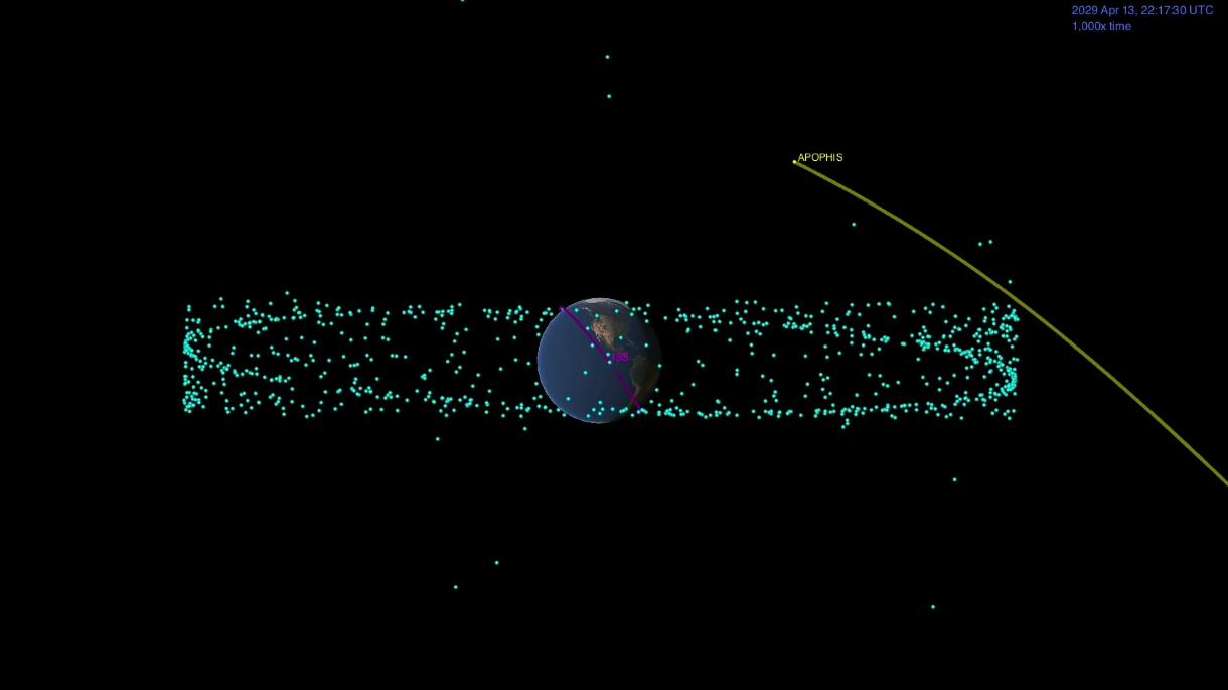Estimated read time: 5-6 minutes
This archived news story is available only for your personal, non-commercial use. Information in the story may be outdated or superseded by additional information. Reading or replaying the story in its archived form does not constitute a republication of the story.
OUTER SPACE — As the dust of 2020 settles, we may find ourselves asking, what's next? While we never know what Jumanji has in store, one thing is sure: check "Doomsday Asteroid" off the list. Asteroid Apophis is going to be a cinch.
On Friday, an asteroid known by its threatening nickname Apophis will harmlessly fly within about 10 million miles of Earth. The near-Earth object, or NEO, will continue on its path around the sun, on a path which space.com said has been unnoticed by humans for millennia.
In eight years, though, we will have cause to take notice when Apophis and Earth again meet at their crossroads at just the right time. On Friday, April 13, 2029, Apophis will pass by Earth at an altitude of about 19,000 miles, NASA reported. That is 90% closer to Earth than our natural satellite, the Moon, and even closer than some of our artificial satellites, too, earthsky.org reported.
Yet, according to NASA/JPL Solar System Ambassador to Utah Patrick Wiggins, even this encounter will be neither peculiar nor perilous. A total of 108 asteroids have come closer to the Earth than the Moon in the past 12 months alone, he told KSL.com. Our current roster of these objects, floating somewhere around space, is a half-million strong and growing each day.
To classify which of these rocks pose a threat, scientists have devised a scale called the Torino Scale, which ranges from 0 to 10. "The higher the number (an object ranks on the scale) the more you want to start looking for another planet to live on," said Wiggins.
Apophis at its worst never made it above one, the space ambassador said. It is currently sitting at zero, according to the NASA/JPL Center for Near Earth Object Studies (CNEOS) website. Scientists actually use a finer scale than this, since nearly all of the potential NEO impacts discovered to-date have a Torino rank of 0, the website explained.
But that is not to say Apophis wouldn't be dangerous, given more unfortunate circumstances.
University of Utah Astronomer Ben Bromley said Apophis, which is about as long as three football fields, could leave a mark in the event of a collision.
"You're talking about obliterating entire cities, possibly small countries," he said, describing an impact. "The area of damage is quite significant."
To put Apophis's potential menace into perspective, Bromley compared it to two events in Earth's history. The first was the Chelyabinsk Meteor, which exploded over Russia in 2013. This object measured just a few yards across, yet its explosion shattered windows for miles. The other extreme example occurred tens of millions of years ago in Mexico's Yucatan Peninsula when an impact brought down the curtains on the dinosaurs. This object measured 5 to 10 miles across.
If I'm going to worry about something, I'll worry about paying my taxes on the 15th of April, not the 13th of April.
–NASA/JPL Solar System Ambassador to Utah Patrick Wiggins
But, the odds are not in Apophis's favor – not in 2029, not in two follow-up meetings in this century. Earthsky.org's report said that collisions have "already been ruled out" in 2029 and in a return visit in 2036. And odds for 2068 are minuscule – one in 380,000 as of February, according to the organization.
"Even if you wanted this, this is a very bad bet," Bromley said.
The encounter in March will aid astronomers in refining those odds. As Apophis flies through space, sunlight heats its surface. Bromley explained the force exerted when this heat is lost nudges the object, introducing uncertainty into the object's future path.
"We aren't going to know for certain where it is headed, over long periods of time," he said of this interaction. On March 5, though, astronomers will be able to take closer measurements of the object and reduce some of this uncertainty, earthsky.org said in their recent report.
Backyard astronomers should be able to spot Apophis in March with a telescope and a camera, said Wiggins, but it won't be much more than a dot. He suggested following the Salt Lake Astronomy Society's Facebook page for details on how to view it.
When Apophis was first discovered, scientists believed it had the potential to hit Earth, because of a region of space called "the needle," Wiggins explained. If Apophis entered this small corridor on April 13, 2029, Earth's gravity could have uncannily swung it around for a hit in 2036 — on the exact same date. Further calculations reduced the size of this corridor, and thus the likelihood of this occurring.
"If I'm going to worry about something, I'll worry about paying my taxes on the 15th of April, not the 13th of April," Wiggins said of this coincidence.
Yet word of the potential earth-clobbering gave Apophis its "cachet," Wiggins said. The NASA ambassador, who has an asteroid named after himself, said the name "Apophis" comes from the villain in the movie Stargate SG-1, who wanted to destroy Earth. The discoverer responsible for the christening bestowed the name in jest, since by then any danger had been ruled out, he said.
According to Bromley, though, the real heroes in this story are NASA scientists, who track objects like Apophis with such precision.
"March is a reminder of how impressive it is that NASA scientists can track, understand and make predictions of this sort," he said of the upcoming encounter. "It's really quite beautiful."









